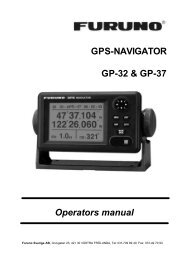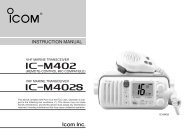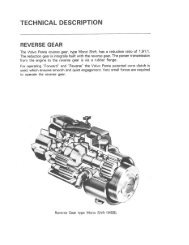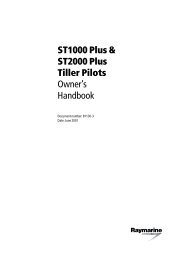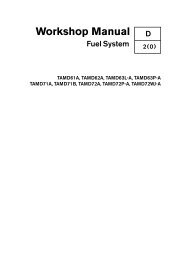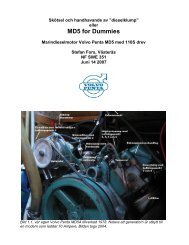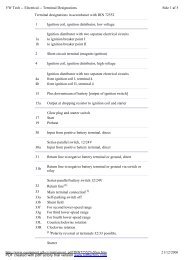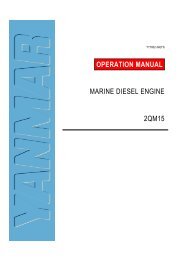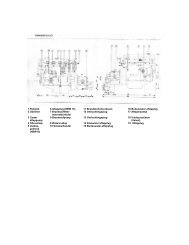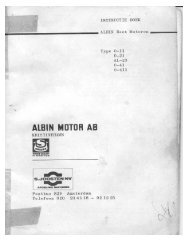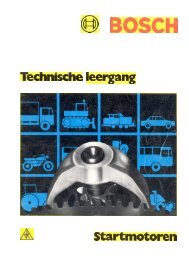You also want an ePaper? Increase the reach of your titles
YUMPU automatically turns print PDFs into web optimized ePapers that Google loves.
224 CHAPTER ELEVEN<br />
3. Push in the detent pin, remove the snap ring and remove<br />
the pin and springs.<br />
4. Use a screwdriver or suitable tool to pry out the seal.<br />
5. Inspect the shift ring. Cfieck the detent notch for excessive<br />
wear that will allow poor clutch engagement.<br />
6. Inspect the detent pin. Replace the pin if it is damaged<br />
or excessively worn.<br />
7. The shift ring contact surface of the shift fork is plated<br />
with molybdenum. Renew the shift fork if the plating is<br />
peeled or the shift fork base metal is exposed.<br />
8. Reassemble the shifter by reversing the disassembly<br />
procedure. Install the shift lever so the triangle mark on<br />
the lever is out.<br />
Reassembly<br />
1. If removed, install the outer bearing races into the<br />
transmission case and mounting flange.<br />
2. Apply sealer to the periphery of the oil seals and install<br />
them into the transmission case and mounting flange with<br />
the open side to the inside.<br />
3. Install the input shaft into the transmission case.<br />
4. Install the intermediate shaft assembly into the transmission<br />
case. Position the thrust washer so the beveled<br />
corner is toward the input shaft. Install a new O-ring on<br />
the intermediate shaft. Use a soft-faced hammer to tap the<br />
shaft into the case.<br />
5. While holding the input shaft out of the way, insert the<br />
output shaft assembly into the transmission case. Move<br />
the gears into mesh on the intermediate shaft, input shaft<br />
and output shaft while installing the output shaft.<br />
6. If the following components have been replaced, refer<br />
to the Bearing Adjustment section: input shaft, input shaft<br />
bearings, output shaft, drive plate, spacer, thrust washers<br />
and output shaft bearings. After adjusting the bearings,<br />
continue to reassemble the transmission as described in<br />
the following steps. If the preceding components have not<br />
been replaced, bearing adjustment is not necessary and<br />
the orginal shims may be reused. Proceed to the following<br />
step.<br />
7. Install the input shaft oil seal.<br />
8. Coat the case mating surface with RTV sealer.<br />
9. Install the mounting flange and tighten bolts evenly.<br />
10. Place the shift ring in neutral position and install the<br />
shift fork through the side opening.<br />
11. Insert the shift bar through the hole in the rear of the<br />
case while installing the shift fork onto the shift bar.<br />
12. Install the shift bar plug. Make sure the threaded end<br />
of the shift bar is installed toward the rear of the case.<br />
13. Install the shifter assembly. Align the marks made<br />
during disassembly and tighten the retaining bolts securely.<br />
Loosen the shift lever clamp bolt and position the<br />
lever so it points up at a 45" angle toward the rear of the<br />
transmission. Retighten the clamp bolt.<br />
14. Check the operation of the transmission. A click<br />
should be audible when the gears are properly engaged. If<br />
the gears do not engage, loosen the shifter retaining bolts<br />
and reposition the shifter. If improper engagement continues,<br />
remove the shifter and check for improper assembly<br />
of the shifting components.<br />
15. Install the O-ring on the output shaft.<br />
16. If not previously installed, install the oil seal into the<br />
case.<br />
17. Install the coupling flange onto the output shaft.<br />
Tighten the retaining nut to the torque specified in Table<br />
2.<br />
18. Install the drain plug and oil dipstick.<br />
19. Fill the transmission with the recommended transmission<br />
fluid. Refer to Chapter Three.<br />
BEARING ADJUSTMENT<br />
Perform the following procedure if the following components<br />
have been replaced: input shaft, input shaft bearings,<br />
output shaft, drive plate, spacer, thrust washers and<br />
output shaft bearings. This procedure determines the<br />
thickness of shims that must be installed so the tapered<br />
roller bearings properly contact the bearing outer races.<br />
1. Install the input shaft, intermediate shaft and output<br />
shafts as described in the Reassembly section.<br />
2. Position the transmission case so the open end is up<br />
and no pressure is being applied to the splined end of the<br />
output shaft.<br />
3. Install the outer bearing races on the input and output<br />
shaft tapered bearings.




